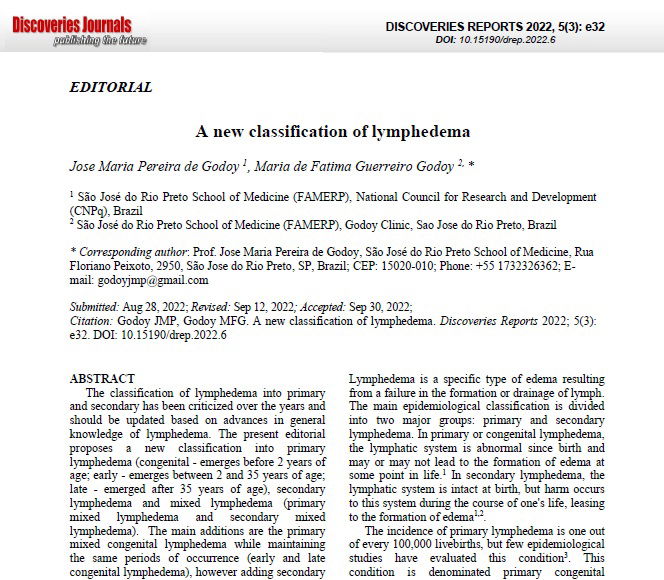DISCOVERIES REPORTS (ISSN 2393249X), 2022, volume 5
REVIEW ARTICLE
CITATION: Godoy JMP, Godoy MFG. A new classification of lymphedema. Discoveries Reports 2022; 5(3): e32. DOI: 10.15190/drep.2022.6
A new classification of lymphedema
Jose Maria Pereira de Godoy 1, Maria de Fatima Guerreiro Godoy 2, *
1 São José do Rio Preto School of Medicine (FAMERP), National Council for Research and Development (CNPq), Brazil
2 São José do Rio Preto School of Medicine (FAMERP), Godoy Clinic, Sao Jose do Rio Preto, Brazil
* Corresponding authors:
Prof. Jose Maria Pereira de Godoy, São José do Rio Preto School of Medicine, Rua Floriano Peixoto, 2950, São Jose do Rio Preto, SP, Brazil; CEP: 15020-010; Phone: +55 1732326362; E-mail: godoyjmp@gmail.com
Abstract
The classification of lymphedema into primary and secondary has been criticized over the years and should be updated based on advances in general knowledge of lymphedema. The present editorial proposes a new classification into primary lymphedema (congenital - emerges before 2 years of age; early - emerges between 2 and 35 years of age; late - emerged after 35 years of age), secondary lymphedema and mixed lymphedema (primary mixed lymphedema and secondary mixed lymphedema). The main additions are the primary mixed congenital lymphedema while maintaining the same periods of occurrence (early and late congenital lymphedema), however adding secondary harm to the lymphatic system, and secondary mixed lymphedema, in which the patient suffers new harm to the lymphatic system, such as that resulting from the occurrence of erysipelas, in addition to the initial harm that caused the lymphedema. The classification of primary mixed lymphedema and secondary mixed lymphedema makes the diagnosis more comprehensive, enabling a more accurate treatment approach and prognosis. This new classification is essential for a better understanding of the diagnosis of lymphedema.
Access FULL text of the manuscript here: FULL ARTICLE (PDF)
REFERENCES
1. Lee BB, Antignani PL, Baroncelli TA, Boccardo FM, Brorson H, Campisi C, et al. IUA-ISVI consensus for diagnosis guideline of chronic lymphedema of the limbs. Int Angiol. 2015 Aug;34(4):311-32.
2. Rockson SG. Lymphedema. Vasc Med. 2016 Feb;21(1):77-81.
3. Smeltzer DM, Stickler GB, Schirger A. Primary lymphedema in children and adolescents: a follow-up study and review. Pediatrics 1985; 76: 206-18.
4. Keo HH, Gretener SB, Staub D. Clinical and diagnostic aspects of lymphedema. Vasa. 2017 Jul;46(4):255-261.
5. de Godoy JMP, de Godoy HJP, Guimarães TD, Godoy MFG. Treatment for chest pain intercurrence after breast cancer surgery using Godoy's intermittent skin therapy. Int J Health Sci (Qassim). 2021 Sep-Oct;15(5):42-45.
6. Pereira de Godoy AC, Guerreiro Godoy MF, Pereira de Godoy LM, Pereira de Godoy HJ, Pereira de Godoy JM. Intensive Treatment for Upper Limb Lymphedema. Cureus. 2021 Sep 16;13(9):e18026.
7. Allen EV, Ghormley RK. Lymphedema of the extremities: Etiology, classification and treatment; report of 300 cases. Ann. Int. Med. 9: 516, 1935
8. Kinmonth JB, Taylor GW, Tracy GD, Marsh JD. Primary lymphoedema; clinical and lymphangiographic studies of a series of 107 patients in which the lower limbs were affected. Br J Surg. 1957 Jul;45(189):1-9.
9. Gordon K, Varney R, Keeley V, Riches K, Jeffery S, Van Zanten M, et al. Update and audit of the St George's classification algorithm of primary lymphatic anomalies: a clinical and molecular approach to diagnosis. J Med Genet. 2020 Oct;57(10):653-659. doi: 10.1136/jmedgenet-2019-106084.
10. Arrivé L, Derhy S, Dahan B, El Mouhadi S, Monnier-Cholley L, Menu Y, Becker C. Primary lower limb lymphoedema: classification with non-contrast MR lymphography. Eur Radiol. 2018 Jan;28(1):291-300.
11. Connell F, Brice G, Jeffery S, Keeley V, Mortimer P, Mansour S. A new classification system for primary lymphatic dysplasias based on phenotype. Clin Genet. 2010 May;77(5):438-52.
12. Executive Committee. The Diagnosis and Treatment of Peripheral Lymphedema: 2016 Consensus Document of the International Society of Lymphology. Lymphology. 2016 Dec;49(4):170-84.
13. Executive Committee of the International Society of Lymphology. The diagnosis and treatment of peripheral lymphedema: 2020 Consensus Document of the International Society of Lymphology. Lymphology 2020; 53:3.
14. Pereira de Godoy JM, de Fatima Guerreiro Godoy M. Functional classification of secondary lymphedema. Ann Med Surg (Lond). 2019 Nov 1;48:81-82. doi: 10.1016/j.amsu.2019.10.025.
15. Ho B, Gordon K, Mortimer PS. A Genetic Approach to the Classification of Primary Lymphoedema and Lymphatic Malformations. Eur J Vasc Endovasc Surg. 2018 Oct;56(4):465-466.
16. Connell F, Brice G, Jeffery S, Keeley V, Mortimer P, Mansour S. A new classification system for primary lymphatic dysplasias based on phenotype. Clin Genet. 2010 May;77(5):438-52.
13. Kaminski TW, Hertel J, Amendola N, et al. National Athletic Trainers' Association position statement: conservative management and prevention of ankle sprains in athletes. J Athl Train. 2013;48(4):528-545. doi:10.4085/1062-6050-48.4.02
14. Wolfe MW, Uhl TL, Mattacola CG, McCluskey LC. Management of ankle sprains [published correction appears in Am Fam Physician 2001 Aug 1;64(3):386]. Am Fam Physician. 2001;63(1):93-104.
15. Stephens MB, Beutler AI, O'Connor FG. Musculoskeletal injections: a review of the evidence. Am Fam Physician. 2008;78(8):971-976.
16. Nichols AW. Complications associated with the use of corticosteroids in the treatment of athletic injuries. Clin J Sport Med. 2005;15(5):370-375. doi:10.1097/01.jsm.0000179233.17885.18
17. Lai MWW, Sit RWS. Healing of Complete Tear of the Anterior Talofibular Ligament and Early Ankle Stabilization after Autologous Platelet Rich Plasma: a Case Report and Literature Review. Arch Bone Jt Surg. 2018;6(2):146-149.
18. Blanco-Rivera J, Elizondo-Rodríguez J., Simental-Mendía M, Vilchez-Cavazos F., Peña-Martínez V. M, Acosta-Olivo C. Treatment of lateral ankle sprain with platelet-rich plasma: A randomized clinical study. Foot and ankle surgery: of icial journal of the European Society of Foot and Ankle Surgeons. 2022; 26(7), 750–754. https://doi.org/10.1016/j.fas.2019.09.004
